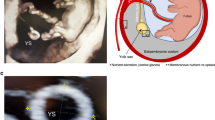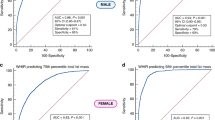Abstract
Objective: To estimate lean body mass (LBM) in preschool aged boys and girls in India and explore gender difference.
Design: Crossectional.
Setting: Immunization clinic of a charitable Government General Hospital in Kolkata, India.
Subjects: Two-hundred and forty-five children (147 boys and 98 girls) aged 1–5 y from among the urban poor were admitted in the study between July 1999 and December 2000. Children with acute or chronic illness or congenital malformation were excluded.
Methods: Length/height to the nearest 0.1 cm, weight to the nearest 10 g and total body resistance using multifrequency bioelectrical (Xitron 4000B) impedance analyzer (BIA) at 50 kHz were measured. Their nutritional status was compared with National Center for Health Statistics (NCHS) median data and lean body mass (LBM) was calculated using anthropometry and BIA equations. The groups were compared using analysis of variance and multiple linear regression.
Results: Girls were more stunted (P<0.001) and underweight (P<0.047), while the degree of wasting was similar. Mean LBM percentage was higher in boys compared with girls by anthropometry (P<0.001) and BIA (P<0.005), which persisted after adjusting for age. With increasing age, LBM percentage declined in girls (P<0.02) in contrast to reference girls, in whom it increased. In boys LBM percentage increased with age as is in reference boys.
Conclusions: In addition to the girls being more stunted and underweight, LBM% decreased in girls with increasing age but steadily increased in boys, suggesting hidden deprivation of female children.
Sponsorship: Partly supported by Nutricia Research Foundation, Netherlands.
This is a preview of subscription content, access via your institution
Access options
Subscribe to this journal
Receive 12 print issues and online access
$259.00 per year
only $21.58 per issue
Buy this article
- Purchase on Springer Link
- Instant access to full article PDF
Prices may be subject to local taxes which are calculated during checkout


Similar content being viewed by others
References
ACC/SCN (2000). Fourth Report on the World Nutrition Situation, Geneva: ACC/SCN in collaboration with the International Food Policy Research Institute
Birch, LL & Fisher, JO (2000). Mothers' child-feeding practices influence daughters' eating and weight. Am. J. Clin. Nutr., 71, 1054–1061.
Bourdel-Marchasson, I, Barateau, M & Sourgen, C et al. (1999). Prospective audits of quality of protein energy malnutrition recognition and nutritional support in critical ill elderly patients. Clin. Nutr., 18, 233–240.
Bourdel-Marchasson, I, Barateau, M & Rondeau, V et al. (2000). A multicentric trial of the effects of oral nutritional supplementation in critically ill older inpatients. Nutr., 16, 1–5.
De Onis, M & Blossner, M (1997). WHO global database on child growth and malnutrition, WHO/NUT/97 4. Program of Nutrition Geneva: World Health Organization
Fauveau, V, Koenig, MA & Wojtyniak, B (1991). Excess female deaths among rural Bangladeshi children: an examination of cause-specific mortality and morbidity. Int. J. Epidemiol., 20, 729–735.
Fisher, JO & Birch, LL (2000). Parents' restrictive feeding practices are associated with young girls' negative self-evaluation of eating. J. Am. Diet. Assoc., 100, 1314–1316.
Fjeld, CR, Freundt-Thurne, J & Schoeller, DA (1990). Total body water measured 18O dilution and impedance in well and malnourished children. Pediatr. Res., 27, 98–102.
Fomon, SJ, Haschke, F, Ziegler, EE & Nelson, EN (1982). Body composition of reference children from birth to age 10 years. Am. J. Clin. Nutr., 35, 1169–1175.
Forbes, GB (1987). Human Body Composition: Growth, Aging, Nutrition and Activity, pp153–154, New York: Springer-Verlag
Frongillo, EA Jr (1999). Introduction. J. Nutr., 129, 529S
Gibson, RS (1990). Principles of Nutritional Assessment, pp166–169, New York: Oxford University Press
Gillespie, SR (1997). Improving adolescent and maternal nutrition: an overview of benefits and options, UNICEF Working Paper, March
Going, SB (1996). Densitometry. In:Human Body Composition, ed. AF Roche, SB Heymsfield & TG Lohman, pp3–24, Champaign, IL: Human Kinetics
Henderson, RC, Lark, RK, Renner, JB, Fung, EB, Stallings, VA, Conaway, M & Stenenson, RD (2001). Dual X-ray absorptiometry assessment of body composition in children with altered body posture. J. Clin. Densitom., 4, 325–335.
Heymsfield, SB, Wang, ZM & Withers, RT (1996). Multicomponent molecular level models of body composition analysis. In:Human Body Composition, ed. AF Roche, SB Heymsfield & TG Lohman, pp129–148, Champaign, IL. Human Kinetics
Janssen, YJH, Deurenberg, P & Roelfsema, F (1997). Using dilution techniques and multifrequency bioelectrical impedance to assess both total body water and extra cellular water at baseline and during recombinant human growth hormone (GH) treatment in GH-deficient adults. J. Clin. Endocrinol. Metab., 82, 3349–3355.
Kushner, RF (1992). Bioelectrical impedance analysis: a review of principles and applications. J. Am. College. Nutr., 2, 199–209.
Mellits, ED & Cheek, DB (1970). The assessment of body water and fatness from infancy to adulthood. Monogr. Soc. Res. Child. Devl., 35, 12–26.
NIH (1994). Bioelectrical Impedance Analysis in Body Composition Measurement, Technological Assessment Statement pp1–35, December (12–14)
Rousham, EK (1996). Socio-economic influences on gender inequalities in child health in rural Bangladesh. Eur. J. Clin. Nutr., 50, 560–564.
Schoenbanu, M, Tulchinsky, TH & Abed, Y (1995). Gender differences in nutritional status and feeding patterns among infants in the Gaza Strip. Am. J. Public. Health., 85, 965–969.
Sellen, DW (2000). Age, sex and anthropometric status of children in an African postoral Community. Ann. Hum. Biol., 27, 345–365.
Shaikh, S, Mahalanabis, D, Kurpad, AV & Khaled, MA (2002). Validation of an anthropometric equation and bioelectrical impedance analysis (BIA) technique to measure body composition of children in India using D2O dilution method. Nutr. Res., 22, 685–694.
Simons,, Fhaj, P, Schols, AMWJ, Westerterp, KR, Velde, GPM & Wouters, EFM (1995). The use of bioelectrical impedance analysis to predict total body water in patients with Cancer Cachexia. Am. J. Clin. Nutr., 61, 741–745.
Tyrrell, VJ, Richards, G, Hofman, P, Gillies, GF, Robinson, E & Cutfield, WS (2001). Foot-to-foot bioelectrical impedance analysis: a valuable tool for the measurement of body composition in children. Int. J. Obes. Relat. Metab. Disord., 25, 164–169.
Ulijaszek, SJ & Kerr, DA (1999). Anthropometric measurement error and the assessment of Nutritional Status. Br. J. Nutr., 82, 165–177.
UNICEF (2001). The State of the World's Children, p83 New York: UNICEF
VanderJagt, DJ, Morales, M, Thacher, TD, Diaz, M & Glew, RH (2001). Bioelectrical impedance analysis of the body composition of Nigerian children with calcium-deficiency rickets. J. Trop. Pediatr., 47, 92–97.
Wang, Z, Deurenberg, P, Wang, W, Pietrobelli, A, Baungartner, RN & Heymsfield, SD (1999). Hydration of fat free body mass: new physiological modeling approach. Am. J. Physiol., 276, E995–1003.
Ward, LC, Elia, M & Cornish, BH (1998). Potential errors in the application of mixture theory to multifrequency bioelectrical impedance analysis. Physiol. Meas., 19, 53–60.
National Academy (1998). The Relationship of Body Composition, Nutrition and Health, Washington, DC: National Academy Press
WHO (1995). Physical status: the use and interpretation of anthropometry. Report of a WHO Expert Committee. WHO Technical Report Series no. 854 Geneva: WHO
WHO (1999). Global Database on Child Growth and Malnutrition. Forecast of Trends, Geneva: WHO, Nutrition Division
Acknowledgements
We thank Mr S Karmakar for typing and editing the manuscript and Dr S Mukherjee of the Infectious Diseases Hospital, Kolkata for her assistance.
Author information
Authors and Affiliations
Contributions
Guarantor: D Mahalanabis.
Contributors: SS, a Research Fellow, carried out the study procedures, took part in the analysis and writing the manuscript. DM proposed the study design, trained SS in statistical analysis, supervized his work, and took part in the data analysis and interpretation and in writing the manuscript. SC supervized anthropometry measurements. AVK took part in the interpretation of the findings, in critical reviewing and editing the manuscript. MAK established the BIA technique and standardized it in the laboratory, trained SS in its use, and took part in preparing and reviewing the manuscript.
Corresponding author
Rights and permissions
About this article
Cite this article
Shaikh, S., Mahalanabis, D., Chatterjee, S. et al. Lean body mass in preschool aged urban children in India: gender difference. Eur J Clin Nutr 57, 389–393 (2003). https://doi.org/10.1038/sj.ejcn.1601571
Received:
Revised:
Accepted:
Published:
Issue Date:
DOI: https://doi.org/10.1038/sj.ejcn.1601571
Keywords
This article is cited by
-
Excess male chronic energy deficiency among adolescents: a cross-sectional study in the context of patrilineal and matrilineal societies in Northeast India
European Journal of Clinical Nutrition (2005)



